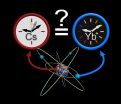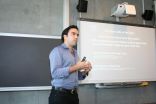The fundamental constants are still constant
Atomic clocks prove the stability of the mass ratio of protons to electrons
2014-11-18
(Press-News.org) This news release is available in German.
Are the fundamental constants really constant? Recent investigations carried out at the Physikalisch-Technische Bundesanstalt (PTB) have shown that one essential fundamental constant - namely the mass ratio of protons to electrons - can have changed only by a maximum of one part in a million over the age of our solar system (i.e. extrapolated over approx. 5 billion years). Previously, scientists deemed the possible changes to be twice as high. To obtain this result, physicists from PTB compared caesium and ytterbium atomic clocks with each other for 7 years. Their results, together with those of a similar experiment carried out at the British metrology institute NPL (National Physical Laboratory), have been published in the current issue of the journal Physical Review Letters.
The Universe is expanding! After this finding in the 1930s, physicists started to speculate whether in such a dynamic universe, constant quantities could exist at all. Maybe even the so-called "fundamental constants" are subject to temporal changes which could give us key information on the structure and the development of the Universe? Since then, one has sought to find evidence of changes undergone by fundamental constants over cosmologic periods of billions of years by means of astrophysical and geophysical observations. The results allowed somewhat contradictory conclusions. In the past few years, laboratory experiments with atomic clocks have attained such an accuracy that it is already possible to contribute to the answer to this question by studying a period of just a few years. If certain fundamental constants changed, then two atomic clocks which are based on different elements would deviate from each other in a predictable manner over time. This method was used at PTB to check the constancy of an essential physical quantity - the mass ratio of protons to electrons - by comparing an optical clock with a trapped ytterbium ion and caesium atomic clocks.
A proton is approx. 1836 times heavier than an electron and, in addition to being subject to the electromagnetic force, it is also subject to the so-called "strong interaction", which is responsible for the structure and the cohesion of atomic nuclei. Variable fundamental constants would lead to changes in the relative strength of these forces, which, in turn, would have an influence on the masses of the particles involved.
The mass of the electron determines the frequency of the optical atomic clocks; the mass of the protons shows in the frequency of the caesium clock (via the properties of the atomic nucleus). When developing the atomic clocks, the caesium clock has repeatedly been compared with the ytterbium clock at PTB over the past few years - with increasing accuracy. These are currently among the most accurate atomic clocks in the microwave and the optical frequency range, respectively. From these data, it was now possible to conclude that the mass ratio of protons to electrons shows no detectable change up to a relative uncertainty of only a few parts per 10-16 per year. Thus, even when extrapolating across the age of our solar system (i.e. approx. 5 billion years), this means a change in this fundamental constant of less than one part in a million, so that it can still be considered a universal and stable quantity.
INFORMATION:
Contact:
Dr. Ekkehard Peik, PTB Department 4.4 Time and Frequency, phone: +49 (0)531 592-4400, e-mail: ekkehard.peik@ptb.de
Original publication:
N. Huntemann, B. Lipphardt, Chr. Tamm, V. Gerginov, S. Weyers, and E. Peik: Improved Limit on a Temporal Variation of mp/me from Comparisons of Yb+ and Cs Atomic Clocks, Phys. Rev. Lett. 113, 210802 (2014). http://dx.doi.org/10.1103/PhysRevLett.113.210802 -
With APS Viewpoint (spotlighting exceptional research): http://physics.aps.org/articles/v7/117
[Attachments] See images for this press release:

ELSE PRESS RELEASES FROM THIS DATE:
2014-11-18
Spices and herbs are rich in antioxidants, which may help improve triglyceride concentrations and other blood lipids, according to Penn State nutritionists.
Triglyceride levels rise after eating a high-fat meal -- which can lead to an increased risk of heart disease. If a high-antioxidant spice blend is incorporated into the meal, triglyceride levels may be reduced by as much as 30 percent when compared to eating an identical meal without the spice blend. The spiced meal included garlic powder, rosemary, oregano, cinnamon, cloves, paprika, turmeric, ginger and black pepper.
Sheila ...
2014-11-18
Scientists have discovered how a gene mutation can lead to diseases that occur when the immune system attacks the body by mistake.
Understanding how these mechanisms work could help scientists to develop new treatments for autoimmune diseases such as Lupus and neurodegenerative conditions including Motor Neurone Disease.
Researchers found that a mutation in the gene - called ADAR1 - causes a defect in an alarm system in our cells that normally protects the body from viruses and other infections. This means that the alarm system is tripped by the cell's own molecules, ...
2014-11-18
A new method for examining the Ebola virus genome could make surveillance quicker and cheaper for West African nations, and help detect new forms of the virus. The detailed procedure is being shared with the research community along with the study paper, which is freely available in the open access journal Genome Biology.
With over 13,000 cases and nearly 5,000 deaths in eight affected countries, the current Ebola outbreak in West Africa is the largest to date, the first to spread to densely populated urban areas, and represents the first time the virus has been diagnosed ...
2014-11-18
Celiac disease patients suffer from gluten intolerance and must adjust to a life without gluten from food sources like wheat, rye and barley. There is no treatment of the disease except lifelong gluten-free diet, but now a Danish/Norwegian research team publishes new research, that may lead to the development of a drug against the disease.
Gluten intolerance is often caused by celiac disease, which makes the human organism sensitive to gluten proteins from certain cereals. No known drug can cure the disease or make the patient able to eat gluten again, and therefore the ...
2014-11-18
A new study has shown for the first time how people can be trained to "see" letters of the alphabet as colours in a way that simulates how those with synaesthesia experience their world.
The University of Sussex research, published today (18 November 2014) in Scientific Reports, also found that the training might potentially boost IQ.
Synaesthesia is a fascinating though little-understood neurological condition in which some people (estimated at around 1 in 23) experience an overlap in their senses. They "see" letters as specific colours, or can "taste" words, or ...
2014-11-18
Researchers at the Bellvitge Biomedical Research Institute (IDIBELL) and doctors at University Hospital of Bellvitge, together with a team of researchers from the University of California, Cincinnati Children's Hospital, California Pacific Medical Center, University of Pittsburgh, University Emory and Stanford University (USA) and the Children's Hospital of Mexico Federico Gomez, have developed a genetic test that identifies patients at high risk of kidney transplant rejection. From a peripheral blood sample and test development easier, you can tell noninvasively and before ...
2014-11-18
For years physicists have been looking for the universe's elusive dark matter, but so far no one has seen any trace of it. Maybe we are looking in the wrong place? Now physicists from University of Southern Denmark propose a new technique to detect dark matter.
The universe consists of atoms and particles - and a whole lot more that still needs to be detected. We can only speculate about the existence of this unknown matter and energy.
"We know that app. 5 pct. of the universe consists of the known matter we are all made of. The rest is unknown. This unknown matter ...
2014-11-18
In 1966, it was Roger Penrose who won the prestigious Adams Prize for his essay "An analysis of the structure of space-time." The Adams Prize - named after the British mathematician John Couch Adams - is awarded each year by the Faculty of Mathematics at the University of Cambridge to a young, UK-based mathematician. At the same time, Steven Hawking won an auxiliary to the Adams Prize for an essay entitled Singularities and the Geometry of Spacetime, shortly after completing his PhD. A copy of the original Hawking submission has now been reproduced in EPJ H.
That year, ...
2014-11-18
"When the discovery was published back in September, we were certain that we had found a Viking ring fortress, but since then there have been intense discussions online and amongst archaeologists about whether we were right. Now we know without doubt that we have found a fortress from the 10th century," says archaeologist Nanna Holm, curator of the Danish Castle Centre.
Two carbon-14 dating results have removed all doubt regarding the authenticity of the Viking fortress. The carbon-14 dating was performed by the AMS 14C Dating Centre at the Department of Physics and Astronomy ...
2014-11-18
HANOVER, N.H. - Dartmouth researchers and their colleagues have created an artificial intelligence software that uses photos to locate documents on the Internet with far greater accuracy than ever before.
The new system, which was tested on photos and is now being applied to videos, shows for the first time that a machine learning algorithm for image recognition and retrieval is accurate and efficient enough to improve large-scale document searches online. The system uses pixel data in images and potentially video - rather than just text -- to locate documents. It learns ...
LAST 30 PRESS RELEASES:
[Press-News.org] The fundamental constants are still constant
Atomic clocks prove the stability of the mass ratio of protons to electrons


